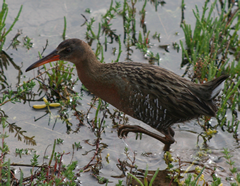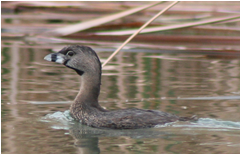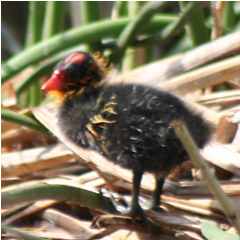| |
|
|
|
|
| |
National Marsh Bird Monitoring and Research Program: A cooperative effort on management areas across North America
|
|
|
| |
|
|
| |
Program Website: |
|
| |
www.ag.arizona.edu/srnr/research/coop/azfwru/NationalMarshBird |
|
| |
|
|
| |
Populations of many species of marsh birds are thought to be declining in North America. Breeding Bird Survey (BBS) data suggests significant population declines for American bittern Botaurus lentiginosus and king rail Rallus elegans. Sample sizes available to detect trends for many other marsh birds are extremely small because the BBS does not adequately sample emergent wetlands. Several species of marsh birds ( Virginia rail, Rallus limicola; sora, Porzana carolina; clapper rail; king rail) are game species in many states and managers need estimates of population trends to set responsible harvest limits. Despite the perceived population declines and game bird status, we currently lack effective monitoring programs to adequately estimate population trends of marsh birds. The primary goal of a continental marsh bird monitoring program for North America would be to estimate population change in marsh birds, with particular emphasis on rails and bitterns. Developing an effective monitoring protocol at the outset is essential for collection of long-term data designed to provide rigorous estimates of population change. The most commonly-used method to determine presence and abundance of marsh birds in local areas is the broadcast of recorded calls. Understanding the magnitude of benefits and drawbacks associated with call broadcast surveys is necessary prior to implementing a continent-wide monitoring program. One potential problem with using call broadcast surveys for a multi-species continental monitoring program is that broadcasting calls of one species may decrease the detection probability of another. Although call broadcast has been shown to increase number of birds detected compared to passive surveys, broadcasting multiple species = calls may negate any increases in detection probability obtained from broadcasting conspecific calls. Alternatively, broadcasting multiple species calls may actually increase detection of each individual species. We also need to examine the influence of call broadcast on detection probability of A non-target @ species (i.e., marsh bird species for which calls are not broadcast). This project involved developing a marsh bird monitoring protocol that would suitable for any area in North America and producing data that can be pooled into one database. For the past 2 years, we have been field-testing these protocols at locations across North America with the help of over 100 marsh bird survey participants. Over half of the participants are individuals working on National Wildlife Refuges. This cooperative effort has produced survey data from over 2000 survey points across North America. The data generated from this partnership will us to answer many methodological questions regarding optimal survey methods for estimating trends of marsh birds at large spatial scales. For example, we will be able to compare vocalization probability, and spatial and temporal variation in vocalization probability, among passive and call-broadcast surveys of the same duration. We will also be able to examine the effect of broadcasting calls of multiple marsh birds on vocalization probability, and compare observer bias between passive and call-broadcast surveys. Participants in this program also are asked to quantify vegetation surrounding each survey point and to record the day and year of the last fire in the area surrounding each survey point. These data will help identify vegetative correlates of species’ presence and absence, and also help evaluate the effects of fire on marsh birds. Based on our results, we will develop a detailed standardized survey protocol to be used for a continental marsh bird monitoring program in North America. This protocol will include everything from survey route selection and point placement to field methods and data forms. |
|
| |
|
| |
Publications: |
| |
 |
|
| |
 |
|
| |
 |
|
| |
 |
|
| |
 |
|
| |
 |
|
| |
 |
|
| |
|
- Erwin, R. M., C. J. Conway, and S. W. Hadden. 2002. Species occurrence of marsh birds at Cape Cod National Seashore, Massachusetts. Northeastern Naturalist 9:1-12e
|
| |
 |
|
| |
 |
|
| |
 |
|
| |
 |
|
| |
 |
|
| |
 |
|
| |
 |
|
| |
 |
|
| |
|
|
| |
Presentations: |
| |
 |
|
| |
|
- Conway, C. J. 2001. "Continental Marshbird Monitoring Program", North American Bird Conservation Initiative; Marshbird Conservation Workshop, Denver, CO.
|
| |
|
|
| |
|
|



